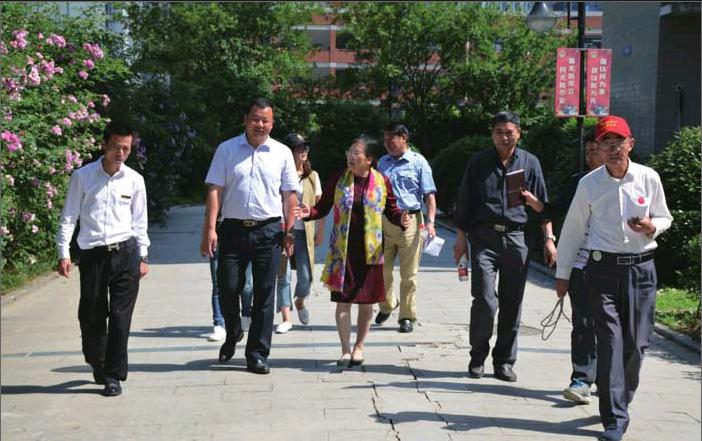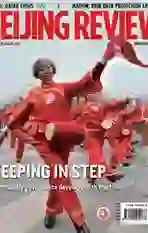GROWING FROM THE GRASSROOTS
2017-07-21ByWangHairong
By+Wang+Hairong


Binhu Century Community is a cluster of vibrant highrises near Chaohu Lake, the fifth largest freshwater lake in China, located in Hefei, capital of east Chinas Anhui Province. Nourished by the humid weather, the plants here are exuberant and refreshingly verdant, adding color and vitality to the neighborhood.
Ni Dalei, a senior resident, resides in one of the highrises. Ni is the leader of a Communist Party of China (CPC) membersgroup based in his building. At least once every month, group members meet at his home, usually around the rectangular dining table in the living room.
The community has 189 such buildingbased CPC members groups, which play an important role in community governance, said Shu Hongying, Party chief of the community. Currently over 6,300 CPC members live and work there.
The community is home to 127,000 people, just 20 percent of whom are farmers native to the area. Eighty percent are migrants from other localities. Governing such a large community that is the size of a small city is challenging.
In China, urban communities are governed by sub-district governments, the lowest unit of government. But since Binhu Century Community is so large, it was put directly under the Baohe District Government.
The community has a Party committee, a joint governance council and a service center. The Party committee lies at the core of the governance framework and plays a coordinating role. The joint governance council acts as a bridge between stakeholders, while the service center offers various services to residents.
Residents who are Party members are expected to play a pioneering role in community affairs and participate in community governance.
Helping hands
When people moved into this community, they did not know one another, let alone help one another. Li Ruihe, Deputy Secretary of the communitys Party committee, said the buildingbased CPC members groups reached out to them, learning about their needs and providing targeted services.
Not long after Ni moved into the community, he received a letter from the communitys CPC committee. He reported to them and initiated the Party membersgroup that now meets at his home regularly.
Hong Dequan, a Party member in his mid-60s, is a member of Nis group. He explained to Beijing Review what their group usually does, “We get together to study the CPCs Constitution and rules, as well as the important speeches of President Xi Jinping. We also visit neighbors to offer help and resolve disputes.”
For instance, the group regularly visits two children living in the building. The siblings, a sixth grader and a second grader, lost both parents in a car accident. Their grandmother, who is in her 50s, came to take care of them from Fuyang, another city in Anhui. The Party members group often checks whether the family needs any help.
Hong, a schoolmaster before retirement, realizes that there are many children in the community and wants to do something for them. With his input, the Party membersgroup has organized a number of extracurricular activities for the youngsters.
In an old-fashioned photo album, Ni pointed out the photographs of such activities. “In this picture, children are releasing fish fry into the ponds to mark International Childrens Day on June 1,” he said. “Here, they are participating in a singing contest during the Dragon Boat Festival.”
Still other photos show children on more outings or receiving safety awareness instructions.
Zhang Mingzhu, 65, also lives in the community. She is the head of another buildingbased Party members group. Zhang, wearing a red vest with “Volunteer” emblazoned on it, patrols the community with other residents. She told Beijing Review that if they spot anything untoward in the community, such as a road section needing repair, they report it to the authorities to have it taken care of.
Zhang is also the founder of a clothes donation charity program. One day, she received a message from an old friend who was a volunteer teacher in a mountain village in southwest Chinas Yunnan Province.
“It is very cold here in winter. Some children do not even have shoes for winter. Could you donate some used clothes and shoes to keep them warm?” the message read.
Zhang immediately called on Party members in the community to donate clothes and footwear and set up a volunteer team to handle the donations. So far, thousands of articles of clothing and footwear have been delivered to children in the Yunnan village and some other places as well.
Now a number of volunteer teams have sprouted up in the community, offering a wide array of services.
Staying close to culture
On a day in June, the community service center, a five-story building opened to the public in 2012, was buzzing with activities in various rooms; ladies were dancing Latin dances, groups of seniors were engrossed in playing poker, pairs of table-tennis players were locked in their games, and a music band was having their rehearsal.
But oblivious to the hubbub, in another room overflowing with calligraphy works spread out on the table, hung up on the walls, and strewn on the floor, a 73-year-old was working on his art intently. It was Yuan Bingxin, a calligraphy aficionado who was bitten by the bug at a young age.
Following his retirement, Yuan had more time to devote to this hobby. After moving into his current home in Binhu Century Community in 2013, he volunteered to teach in the communitys university for senior citizens and also taught calligraphy to children.
“I have taught between 100 and 200 senior students in the university,” he told Beijing Review. “Some of them have won awards in calligraphy contests.”
He and his students gift their work to other residents, especially before the Chinese Lunar New Year, a traditional time for people to paste auspicious couplets on doors and redecorate their homes.
Yuan appreciates the communitys effort in promoting calligraphy. The paper used in his calligraphy class is provided by the community service center for free.
In addition to the university, the spacious center houses other facilities serving residents, including a reading room, a recreational room for pre-school children, a multimedia workshop and a charity workshop providing free office space for more than 70 non-profit groups. The front desk offers other services such as property management.
Data provided by the communitys Party committee show that so far, 12,000 residents have studied in the university for senior citizens or participated in cultural and recreational activities in the center, and more than 20,000 people have used the reading room.
Engaging stakeholders
In one room, members of the communitys joint governance council were in the middle of a meeting. The councils Secretary General Jiang Bingan, said the members are drawn from organizations and individuals in the community that care about the communitys development and are willing to assist in it.
“The council serves as a bridge between the Party committee and concerned organizations and individuals,” Jiang said. It promotes joint contribution and shared benefits and seeks to engage various stakeholders in community governance.
A focus of the council is to push forward the consultation mechanism for dispute resolution, Li added. For instance, residents have different opinions on the communitys door-access policy. Some insist there should be a swipe card, while others would like open access to save the bother of swiping the card. Such disagreements are handled through consultation, he said.
Another important mission of the council is to find organizations to sponsor or run charity projects benefiting the community.“We identify residents needs and concerns; meanwhile, we also learn about the needs of enterprises, either public or private, and match them,” Li said.
This year, the council has received 82 applications for funding, and approved 52 of them.
To secure funding, the communitys Party committee has partnered with more than 30 organizations in the community and raised 2.6 million yuan ($370,000) in three years. The money was spent on microcharity projects such as putting up benches inside the community, building a parking lot beside a hospital and bathrooms in a nearby park, and creating a zebra crossing in front of the community kindergarten.
“These micro-charity projects directly pertain to the interests of residents, so doing them well will improve residents satisfaction and community governance,” Jiang said.
Tangible results
Binhu Century Communitys governance model has several distinct features, explained Wu Zongyou, a professor at the School of Sociology and Political Science of Anhui University and Vice Chairman of the Anhui Association of Social Workers.
The government has set up platforms to engage residents, including the joint governance council, the service center and social groups. The governance model is service-based and people-oriented and good neighborly relations are fostered through volunteering activities.
Internet technology is used in community governance. Multimedia platforms facilitate information sharing between various stakeholders, enabling the public to participate in the communitys decisionmaking process and oversee community governance on one hand, and the communitys governance bodies to prevent and control social risks on the other hand, Wu said.
This innovative governance models effectiveness in social governance has won it more than 30 national and provincial honors.
Compared with conventional models, it has slashed administrative costs by two thirds, Li, Deputy Secretary of the communitys Party committee, added.
Costs have been reduced mainly because of both the absence of a sub-district government between the district government and the community and the business investment channeled into community development through the joint governance system, said Chen Guimin, Chairman of the China Community Development Association.
The new model has also increased work efficiency and service quality, he added.
Chen thinks that neighbors care for one another and cultural activities are important for restoring psychological balance, which may be disturbed during social transition.
Binhu Century Community was born during Chinas urbanization drive. In the current rapid social transformation period, it is often not easy for people to adjust to social changes. Maladjustment may give rise to anxiety and other psychological crises and could be socially destabilizing, Wu said.
While speaking highly of the models merits, Chen has some suggestions for its further development.
Currently, the joint governance council has 89 members, including 42 organizations and 47 individuals, and council members elect the chairman and directors, according to the councils Secretary General Jiang.
Chen proposes that residents directly or indirectly elect the communitys decisionmaking and oversight bodies. Also, studies should be carried out on how to ensure that the joint governance council better represents the will and interests of residents.
